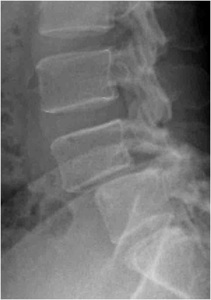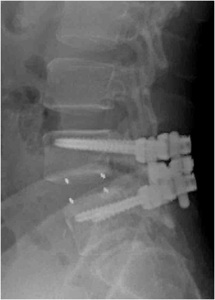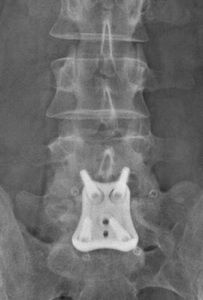Contact ☎ 310.448.7844
ALIF
Anterior Lumbar Interbody Fusion. A fusion entails one vertebral body (ex. L4) fusing to another (ex. L5). This provides stability and decreases pain from the facet joints and disc (ex. L4-5) in between the vertebral bodies. The ALIF procedure has the benefit of obtaining excellent fusion potential thru a minimally invasive approach. Minimally invasive surgery entails minimal damage to muscles in the approach to the spine. The ALIF incision is beside the umbilicus. The rectus muscles are mobilized without cutting or damaging them. The abdominal contents are contained in a sac (peritoneum) which is moved from left to right to gain access to the spine. The disc is removed and replaced with a large spacer (typically plastic or bone) and bone graft (or substitute such as BMP). The size of the spacers inserted thru the anterior approach is typically twice the size of spacers inserted from the back (TLIF or PLIF approach). The larger spacers provide increased stability, increase the disc height in order to restore alignment, and increase the chance of successful fusion. Pedicle screws, which may be used for additional stability, are inserted into the bone in order to stabilize the motion segment (ex. L4-5) and increase fusion rate. We insert our pedicle screws under three-dimensional computer navigation which increases the accuracy and safety of the procedure. Ninety-one percent of our patients have had pain reduction with an ALIF procedure with an average pain reduction from 8/10 pre-op to 3/10 post-op.
ALIF Demonstration
Case Study
Here is an example of a patient that underwent an ALIF procedure with pedicle screw placement. The patient suffered from back and bilateral leg pain for 2 years. He failed conservative management in the form of physical therapy, spinal injections, oral medications, and activity modification. He underwent the ALIF procedure with a PEEK spacer, posterior pedicle screws, and decompression. His pain reduced from 9/10 pre-op to 3/10 postop (final follow-up 18 months).


Here is an example of an ALIF procedure with an anterior plate. The benefit to the anterior plate is that only the muscle-sparing anterior approach is done (from the front), with no disruption of the posterior back muscles. The patient suffered with back and left leg pain. He had undergone intensive physical therapy trunk stabilization exercises and multiple spinal injections. He underwent a fusion at L5-S1 via ALIF and pedicle screws and decompression in order to treat his degenerative disc disease and stenosis. The patient’s pain decreased from 8/10 pre-op to 3/10 post-op (last follow-up was two years post-op).




ALIF - LUMBAR FUSION
For a description of the ALIF, please click here
For a description of the XLIF/DLIF, please click here
For a description of the TLIF, please click here
For a description of the PLIF, please click here
We prefer a TLIF to a PLIF because we think it requires less nerve root retraction and is safer for the patient. They are very similar procedures, both done from the back.
